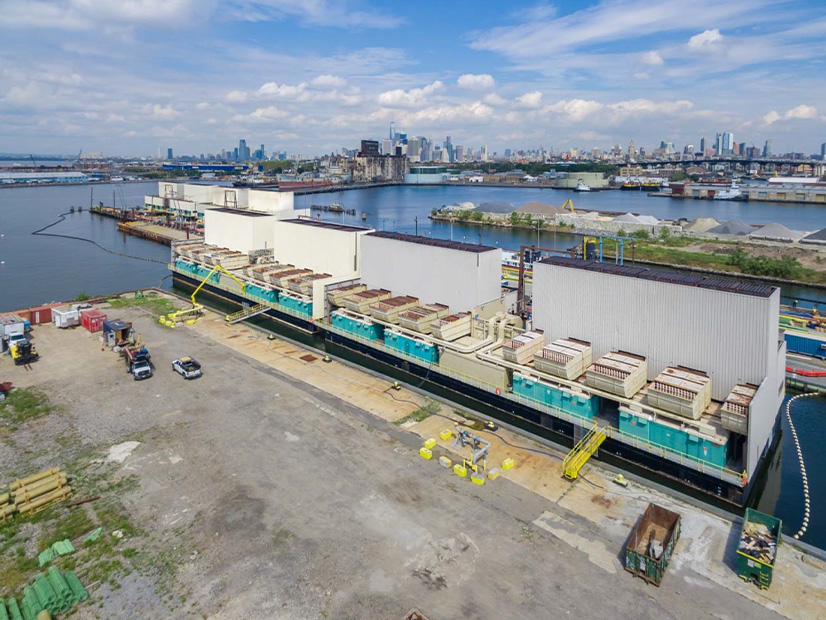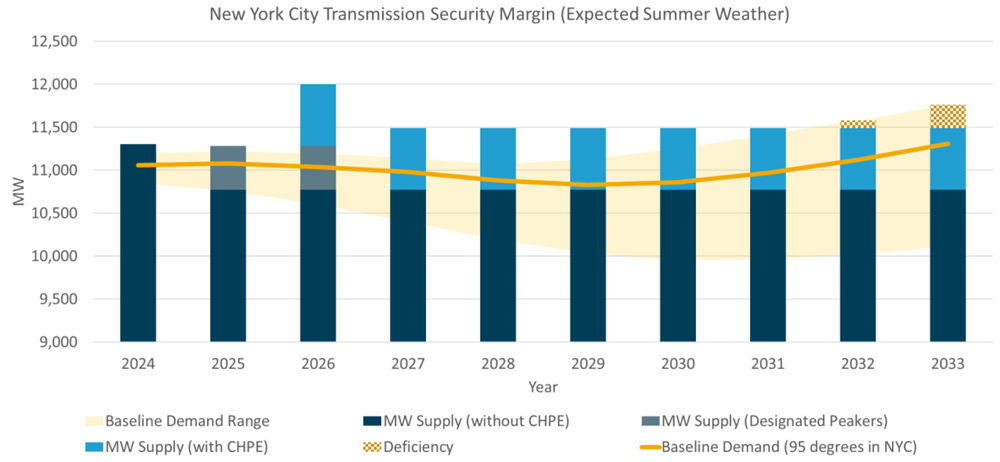
NYISO announced Nov. 20 it will keep two natural gas peaker plants in Brooklyn operational beyond their state-mandated retirement to address a generation shortfall in New York City.
The ISO’s Nov. 20 Short-Term Reliability Process Report said the Gowanus 2 & 3 and Narrows 1 & 2 barge-mounted power plants will remain online to help plug a 446-MW reliability deficit.
The deficit was identified in NYISO’s second quarter Short Term Assessment of Reliability, which said the city would be short for up to nine hours on the peak day in 2025 during expected weather conditions, assuming forecasted economic growth and policy-driven increases in demand. (See NYC to Fall 446 MW Short for 2025, NYISO Reports.)
The two facilities, owned by Astoria Generating Co., collectively can generate 564.9 MW and contribute 508 MW toward New York City’s transmission security margin.
The Gowanus facility has been operational since 1971 and compromises 32 simple-cycle combustion turbines, each with a nameplate value of 20 MW. The Narrows facility has been running 32 similar units since 1972, but with a nameplate value of 22 MW.
NYISO’s decision highlights the challenges New York faces in balancing reliability with environmental regulations and increasing energy demands under electrification.
NYISO Chief Operating Officer Emilie Nelson said the ISO is committed to a reliable transition to emissions-free resources and is aware of how fossil fuel plants — a source of ozone-contributing pollutants — affect surrounding communities. “This means running these units only when conditions require, and closing them when no longer necessary for reliability,” she said.
The ISO’s report says Gowanus and Narrows help New York City’s bulk power transmission system during unexpected facility outages or during extreme weather conditions like a heat wave when other power producers may become unavailable.
The units were set to retire May 1, 2025, to comply with the Department of Environmental Conservation’s 2019 Peaker Rule, which imposes nitrogen oxide emissions limits on fossil fuel plants. NYISO reports that 1,027 MW of peakers had ceased or limited their operation as of May 1, 2023, with an additional 590 MW scheduled to go offline by the 2025 deadline, all of them in New York City.
The peaker rule allows plants needed for reliability to remain operational until May 1, 2027, with a potential two-year extension to May 1, 2029.
NYISO anticipates improved generation margins in 2026 with completion of the 339-mile Champlain Hudson Power Express, which will carry up to 1,250 MW of hydropower from Quebec to New York City. If the project is delayed, or if more power plants are retired, or demand exceeds forecasts, the city could experience a reliability shortfall for up to 10 years.
Even with CHPE, “the margin gradually erodes through time thereafter as expected demand for electricity grows,” the ISO said. And it noted that while CHPE will help summer reliability, it is not expected to provide any capacity in the winter. New York’s winter electricity demand is forecast to increase over the next decade.
The decision to keep the Gowanus and Narrows plants operational was a last resort, made after alternative proposals failed to present viable solutions that could address the 446-MW deficiency and be installed before 2025.
Con Edison proposed installing roughly 16 miles of 345-kV underground cables and associated stations. The ISO said the proposal was rejected because the project would not be completed until “well after” the CHPE’s anticipated in-service date.
Orenda, a renewable energy storage supplier, proposed a reliability must-run solution involving small battery storage projects interconnected with Con Ed’s distribution system. However, the ISO deemed this output — a maximum of 27 MW over four hours, or up to 12 MW over the nine-hour duration of the need — insufficient. “The total capability of the Orenda batteries is less than the output of the smallest Gowanus or Narrows peaker,” the ISO noted.
The ISO said it received no market-based proposals to solve the shortfall.
“NYISO is working very closely with the DEC, the Public Service Commission and NYSERDA [the New York State Research and Development Authority] as we address the reliability need in New York City and a reliable transition to renewable resources for the state,” Nelson said.

